3D printed figurines are small, detailed models created using advanced 3D printers. These figurines capture the likeness of people, characters, or objects in a unique and personalized way. They are popular for gifts, collectibles, art, and promotional uses.
The process starts when you upload photos or digital designs.
Skilled artists turn these inputs into detailed 3D models and 3D files using modeling software.
These files guide the 3D printer to build the figurine layer by layer.
Most creators use materials like resin or PLA.
After printing, the figurines go through finishing steps such as sanding, painting, and assembling any movable parts.
Choosing the right material affects the quality and cost. Resin offers a smooth finish and high detail. PLA is eco-friendly and affordable. Depending on your needs, you can select the best option for your custom figurine.
3D printed figurines serve many purposes. They make special gifts and keepsakes, unique art pieces, or marketing tools for businesses. Compared to traditional sculpting, 3D printing is faster, more precise, and often more affordable.
To get the best results, provide clear, high-quality photos from different angles. This helps artists create accurate 3D models and 3D files. Also, consider the size and materials when placing your order. Choose a reputable vendor to ensure quality and timely delivery.
caring for the environment is important. PLA breaks down naturally, making it a greener choice. Resin offers fine detail but is harder to recycle. Ask your vendor about their eco-friendly practices and recycling programs.
Many vendors offer options for personal touch, such as different poses, clothing, or accessories. Some figurines have movable joints, adding fun and realism. Keep in mind that movable figurines may require more assembly and cost extra.
Packaging can enhance your experience. Custom boxes, display stands, and certificates of realness protect your figurine and add value.
If you prefer, some vendors provide 3D models and 3D files only. You can print these yourself or use them in virtual settings like games or animations.
Good services provide previews before printing. This lets you request changes to pose, color, or details to get exactly what you want.
How 3D Printed Figurines Are Made
The process begins when you upload photos or designs. Artists create detailed 3D models that capture your subject’s features. These files act as blueprints for the printer.
The 3D printer builds the figurine layer by layer using materials such as resin or PLA. Printing times vary depending on size and complexity.
Once printed, the figurine undergoes finishing touches. Experts sand rough edges, paint, and assemble movable parts to create a polished final product.
Common Uses of 3D Printed Figurines
3D printed figurines are great as personalized gifts and keepsakes. Artists and collectors appreciate their fine detail and uniqueness.
Businesses use them as branded merchandise or promotional items to attract attention and build customer loyalty.
Digital enthusiasts use 3D models and 3D files in games, animations, or for 3D printing at home.
Advantages Over Traditional Sculpting
3D printing is much faster than hand sculpting. It delivers higher precision and detail. Plus, it is often more affordable, especially for small runs or custom orders.
You can preview and revise digital files before printing, reducing errors and unhappiness.
Tips for Ordering Your Figurine
Start with clear, high-resolution photos showing multiple angles. Communicate your preferences clearly.
Ask about materials and choose based on your priorities like detail, cost, or eco-friendliness.
Check the vendor’s reputation and delivery times. Make sure they offer proofing before final printing.
Consider packaging options to protect and showcase your figurine.
For more on 3D printing, see Autodesk’s guide to 3D printing basics. Ready to create your custom figurine? Visit hibuu.com/custom-3d-figure-photo.

